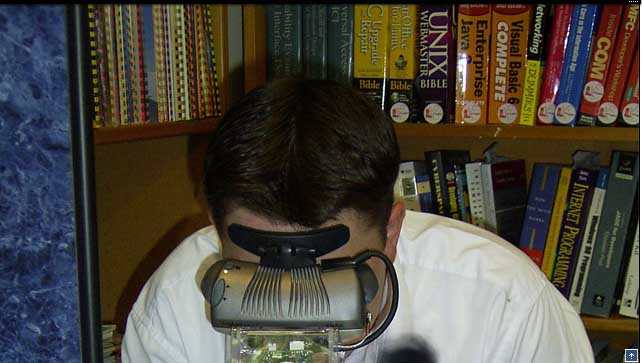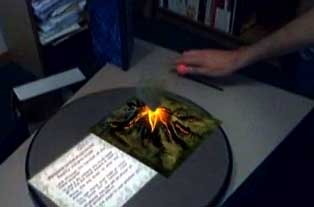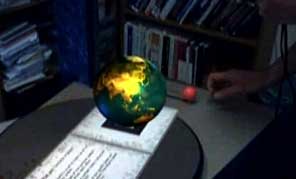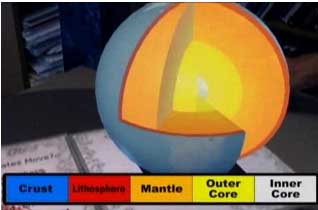« "The American Film" -- Using WebCT To Author Digital Texts | Main | Narrative Structure and Medium: "The Red Planet" and the Future of the Educational DVD-ROM »
January 3, 2006
Reading the "Augmented" Digital Text: AR Volcano

When we talk about "digital textbooks" here at Next/Text, we're usually referring to textbooks that have moved from the printed page to the computer screen. But there are other types of digital texts -- and digital learning environments -- that move beyond the boundaries of the screen to rethink our assumptions of what books might be. One example is the use of augmented reality to create texts which resemble books in their basic physical form, but have features that dramatically alter the experience of reading and learning.
Over the past five years, HCI engineer Mark Billinghurst (formerly based at the University of Washington and now director of the Human Interface Technology Lab at the University of New Zealand) has been working on a series of "magic books" which use AR technology to project three-dimensional animations off of each page, allowing the user to learn about a topic by watching a series of scenarios and demonstrations at their own pace. AR Volcano, created with the assistance of Eric Woods, Graham Aldridge, uses AR to teach students about the science of volcanoes, including details on tectonic plates, subduction, rifts, 'the ring of fire,' volcano formation, and eruptions. I'm going to discuss this project here, with the caveat that I haven't used it: I've only read through articles and documentation and watched a few demonstration videos.
What is augmented reality? While most digitally literate folks might be familiar with virtual reality, augmented reality has generally gotten less attention. An article from from the April 2002 issue of Scientific American neatly outlines the differences between the two media:
Augmented reality (AR) refers to computer displays that add virtual information to a user's sensory perceptions. Much AR research focuses on "see-through" devices, usually worn on the head, that overlay graphics and text on the user's view of his or her surroundings. (Virtual information can also be in other sensory forms, such as sound or touch, but this article will concentrate on visual enhancements.) AR systems track the position and orientation of the user's head so that the overlaid material can be aligned with the user's view of the world. Through this process, known as registration, graphics software can place a three-dimensional image of a teacup, for example, on top of a real saucer and keep the virtual cup fixed in that position as the user moves about the room. AR systems employ some of the same hardware technologies used in virtual-reality research, but there's a crucial difference: whereas virtual reality brashly aims to replace the real world, augmented reality respectfully supplements it.

The image above illustrates how Billinghurst's AR Volcano supplements the reality of the "book" that the user encounters. Without goggles, someone approaching AR Volcano would only see what looked like a conventional paper book propped (albeit one which is only six pages long) on a podium. With the goggle, the computer software recognizes special patterns embedded in the book and replaces them with photo-realistic 3D objects. In this photo, a volcanic eruption takes place over the course of several minutes. The image will appear no matter where the user positions themselves around the book, and a new image can be seen by simply turning the page.
AR Volcano has a significant feature that sets it apart from Billinghurst's previous magic books and makes the technology much more suitable for creating learning environments. In earlier books -- such as the Black Magic Book, which tells the story of the America's Cup Race -- the user was positioned as a passive spectator in an enhanced "reading" environment. AR Volcano, however, provides an interactive slider that allows the user to control volcano formation and eruption as well as the movement of tectonic plates. In the image above, the slider (a physical slider attached to the book podium), is adjusted so that the volcano is erupting at a rapid pace; in the image below, the slider is adjusted downwards so that the movement of tectonic plates on the earth's surface occurs more gradually. The audio narrative also adjusts, so that it keeps pace with the user's movement through the pages of the book.

Another useful feature, common to all "magic books," is a zoom function connected to the user's experience of physical space -- simply put, as a user moves physically closer to the book the image grows larger, mirroring the experience of approaching an object in the real world. The photo below is taken from the vantage point of someone who has moved closer to the 3-D visualization of the earth's various layers in order to examine it more closely. Notice that the three-dimensional globe is overlaid with a two-dimensional text label which color-keys the layers indicated by the cross-section.

Since it reflects a user's bodily experience, the physical zoom enhances the reality effect of AR books; ideally, the technology will evolve to the point where the augmentations will become less cartoonish and more natural, even "transparent" to the user. The improvement of what AR designers call the "immersion effect" is the focus of another project at Billinghurst's HIT lab, AR Relight, which attempts to improve shadow casting in 3D models.
Making AR more believable is only one of the challenges faced by researchers like Billinghurst; another is integrating interactive functions into a text in a manner that would make it more portable and booklike than AR Volcano; while the Black Magic Book resembles a conventional spiral bound volume, AR Volcano depends on its computerized podium. Since portability is one of the hallmark features of textbooks -- including digital ones, if one has a laptop -- the technology has a ways to go before it can emulate the combination of interactivity and portability of the Young Ladies' Illustrated Primer imagined by Neal Stephenson in his novel The Diamond Age, a book which uses the wonders of nanotechnology to generate three dimensional, interactively narrated animations to guide the protagonist through the challenges of her girlhood.
AR researchers probably won't need to wait for functional nanotechnology to make viable AR books that could be used in teaching contexts; medical books, for example, in which 3D visualizations emerge from the pages. Alternately, educational uses of AR might move away the book metaphor as a means of navigation: for example, a project called MARIE at the University of Sussex uses AR technology to allow students taking online courses to view and interact with three-dimensional objects that the instructor is describing. But AR has made its impact as a way of imagining a form of digital textuality that is not physically wedded a computer screen -- or, for that matter, to immersion in an entirely simulated world.
For those who are interested in experimenting with the technology themselves, Billinghurst and his group have released an AR toolkit, which they describe as "a collection of libraries, utilities applications, and documentation and sample code aimed at creators of augmented reality applications." The libraries allow users to capture images from video sources, process those images to optically track markers in the images, composite computer-generated content with the real-world images, and finally display the result using the graphics language OpenGL.
Posted by lisa lynch at January 3, 2006 2:35 PM
